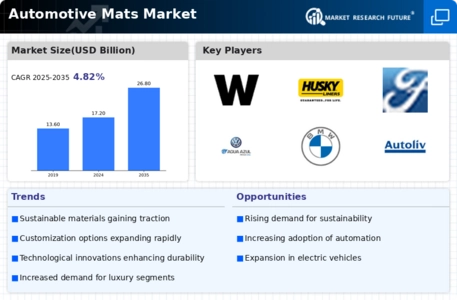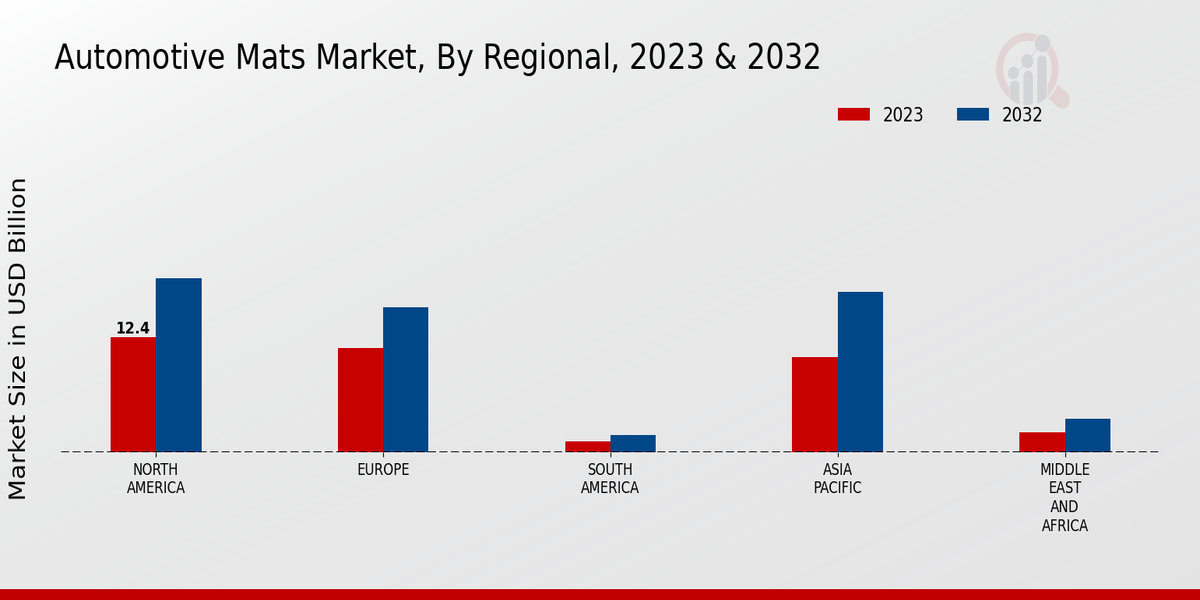Market Growth Projections
The Global Automotive Mats Market Industry is projected to experience substantial growth over the next decade. With an anticipated market value of 26.8 USD Billion by 2035, the industry is expected to witness a compound annual growth rate (CAGR) of 4.15% from 2025 to 2035. This growth trajectory suggests a robust demand for automotive mats, driven by factors such as rising vehicle production, increased consumer awareness, and technological advancements. As the market evolves, manufacturers are likely to adapt to changing consumer preferences and invest in innovative solutions to meet the demands of a dynamic automotive landscape.
Growing Consumer Awareness
Consumer awareness regarding vehicle maintenance and interior aesthetics is a significant driver for the Global Automotive Mats Market Industry. As individuals become more conscious of the importance of protecting their vehicle interiors, the demand for high-quality mats increases. This trend is particularly pronounced in urban areas, where vehicles are exposed to various environmental factors. Consequently, consumers are more inclined to invest in mats that offer durability and ease of cleaning. The market is likely to benefit from this shift in consumer behavior, as more individuals recognize the value of automotive mats in preserving their vehicle's resale value.
Rising Automotive Production
The Global Automotive Mats Market Industry is poised for growth, driven by the increasing production of vehicles worldwide. In 2024, the market is projected to reach 17.2 USD Billion, reflecting a robust demand for automotive accessories, including mats. As manufacturers ramp up production to meet consumer demand, the need for high-quality mats that enhance vehicle aesthetics and functionality becomes paramount. This trend is particularly evident in emerging markets, where automotive production is expanding rapidly. The integration of advanced materials in mat manufacturing further supports this growth, as consumers seek durable and stylish options for their vehicles.
Expansion of E-commerce Platforms
The expansion of e-commerce platforms is transforming the Global Automotive Mats Market Industry by providing consumers with greater access to a wide range of products. Online shopping has become increasingly popular, allowing consumers to compare prices, read reviews, and make informed purchasing decisions from the comfort of their homes. This trend is particularly beneficial for niche products like automotive mats, which may not be readily available in local retail stores. As e-commerce continues to grow, it is likely to facilitate market expansion, enabling manufacturers to reach a broader audience and increase sales. The convenience of online shopping is expected to play a crucial role in shaping consumer purchasing behavior.
Increase in Vehicle Customization
The trend towards vehicle customization is significantly influencing the Global Automotive Mats Market Industry. Consumers are increasingly seeking personalized options to enhance their vehicle interiors, leading to a surge in demand for custom-fit mats. This customization trend is particularly popular among younger demographics, who view their vehicles as an extension of their personal style. As a result, manufacturers are expanding their offerings to include a variety of designs, colors, and materials. This growing emphasis on personalization is expected to drive market growth, as consumers are willing to invest in mats that reflect their unique preferences.
Technological Advancements in Materials
Technological advancements in materials used for automotive mats are reshaping the Global Automotive Mats Market Industry. Innovations such as eco-friendly materials and advanced manufacturing techniques are gaining traction among manufacturers. These developments not only enhance the durability and performance of mats but also align with the growing consumer preference for sustainable products. As the market evolves, manufacturers are increasingly adopting materials that are both functional and environmentally friendly. This shift is expected to attract a broader consumer base, particularly among environmentally conscious buyers, thereby contributing to the market's projected growth.











